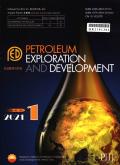Geochemical differences in natural gas of Sinian Dengying Formation on the east and west sides of the Deyang-Anyue rift trough and their genesis, Sichuan Basin, SW China
IF 8
Q1 ENERGY & FUELS
引用次数: 0
Abstract
Taking the natural gas reservoirs of the Sinian Dengying Formation on the east and west sides (Gaoshiti-Moxi area and north slope of central Sichuan paleo-uplift on the east; Weiyuan and Well Datan-1 block on the west) of the Deyang-Anyue rift trough in the Sichuan Basin, China, as the research object, the geochemical parameters (component, isotopic composition) of natural gas from the Dengying Formation in different areas are compared, and then the differences in geochemical characteristics of Dengying natural gas on the east and west sides of the Deyang-Anyue rift trough and their genesis are clarified. First, the Dengying gas reservoirs on both sides of the rift trough are predominantly composed of oil-cracking gas with high maturity, which is typical dry gas. Second, severely modified by thermochemical sulfate reduction (TSR) reaction, the Dengying gas reservoirs on the east side exhibit high H2S and CO2 contents, with an elevated δ13C2 value (average value higher than −29‰). The Dengying gas reservoirs in the Weiyuan area are less affected by TSR modification, though the δ13C1 values are slightly greater than that of the reservoirs on the east side with partial reversal of carbon isotope composition, likely due to the water-soluble gas precipitation and accumulation mechanism. The Dengying gas reservoir of Well Datan-1 shows no influence from TSR. Third, the Dengying gas reservoirs reflect high helium contents (significantly higher than that on the east side) in the Weiyuan and Datan-1 areas on the west side, which is supposed to attribute to the widespread granites in basement and efficient vertical transport along faults. Fourth, controlled by the paleo-salinity of water medium in the depositional period of the source rock, the δ2HCH4 values of the Dengying gas reservoirs on the west side are slightly lighter than those on the east side. Fifth, the Dengying natural gas in the Datan-1 area is contributed by the source rocks of the Sinian Doushantuo Formation and the third member of the Dengying Formation, in addition to the Cambrian Qiongzhusi Formation.
四川盆地德阳—安岳裂谷东西两侧震旦系灯影组天然气地球化学差异及其成因
以中国四川盆地德阳-安岳断裂槽东西两侧(东侧为高石梯-磨溪地区、川中古隆起北坡;以中国四川盆地德阳-安岳断裂槽东西两侧(东侧为高石梯-磨溪地区和川中古隆起北坡;西侧为威远和井大滩-1区块)的中年登瀛层天然气储层为研究对象,对比不同地区登瀛层天然气的地球化学参数(组分、同位素组成),阐明德阳-安岳断裂槽东西两侧登瀛层天然气地球化学特征的差异及其成因。首先,裂谷两侧的登封气藏主要由高成熟度的裂油气组成,属于典型的干气。其次,由于受到热化学硫酸盐还原反应(TSR)的严重改造,东侧的登瀛气藏表现出较高的 H2S 和 CO2 含量,δ13C2 值升高(平均值高于-29‰)。威远地区的登瀛气藏受TSR改造的影响较小,但δ13C1值略大于东侧气藏,碳同位素组成出现部分逆转,可能是水溶性气体析出和积聚机理所致。大滩-1井的登瀛气藏没有受到TSR的影响。第三,登瀛气藏西侧威远和大滩-1区氦含量较高(明显高于东侧),这可能是由于基底花岗岩广泛分布,沿断层垂直运移效率高所致。第四,受源岩沉积期水介质古盐度的控制,西侧登瀛气藏δ2HCH4 值较东侧气藏稍轻。第五,大滩-1区的丹营天然气除寒武系琼珠寺地层外,还有新元古代豆山头地层和丹营地层第三系的源岩贡献。
本文章由计算机程序翻译,如有差异,请以英文原文为准。
求助全文
约1分钟内获得全文
求助全文

 求助内容:
求助内容: 应助结果提醒方式:
应助结果提醒方式:


